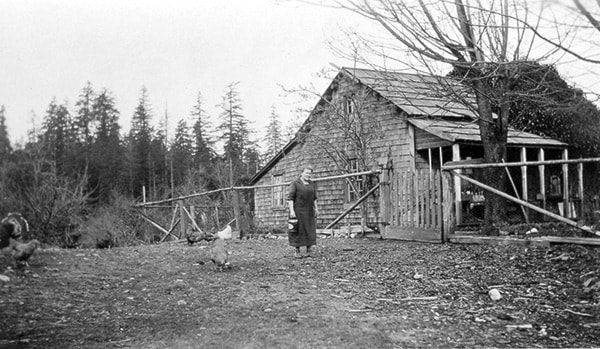Jeanette Taylor
Special to the Mirror
Though the recent freak snow storm doesn’t happen often on the Island, Quadra Island’s first English-speaking woman settler was greeted with a snowstorm that by all accounts puts ours to shame back in 1890.
Loneliness plagued most of the bachelors who settled on the Discovery Islands in the 1890s, when the Euro-Canadian gender balance was about ten men to one woman.
It wasn’t so bad in spring and summer, when men worked in logging camps to earn a grubstake. It was the short days of winter, working alone to clear their land, that wore them down.
“Snowed a bit in night,” Campbell River settler Fred Nunns wrote in his diary. “Got out a few [fence] rails, drizzling rain in afternoon. Feeling very lonely, tired of reading.”
Jack Bryant of Quadra Island solved this problem by going home to England, after a twenty year absence. While there he married his cousin Mary Shepperd, who he’d last seen when he attended her christening—just before emigrating twenty-seven years before.
The newlyweds arrived on Quadra Island in July 1889. Mary was greeted like a queen at a logging camp in Quathiaski Cove, as the island’s first English-speaking woman. From there, the loggers hauled her crates and trunks up the long forest trail to Jack’s homestead.
Mary was newly pregnant that summer, canning berries, fish and venison on the cabin’s cast iron stove in readiness for winter. Those glittering jars of food were a blessing when the snow began to fall on Christmas day and continued for weeks on end.
By mid-January, just weeks before Mary’s due date, their house was buried in soft snow.
Roofs had to be shovelled daily, forming crenellated parapets around settlers’ cabins and outbuildings.
“The entire district was blocked with snow up to eight feet deep, with no possibility of getting in supplies for two months,” wrote a Comox Valley settler.
Most people ran out of firewood and had to dig tunnels to get at their fence posts to keep their fires burning. “At last, after New Years,” wrote this man, “the wind went north, the sky cleared, and the heavy, damp snow froze to a depth of six inches.”
This frozen crust allowed Jack and Mary to get down the forest trail to Quathiaski Cove, where Jack dug his canoe out from its shelter. It took the better part of that day to reach Comox, where they caught a southbound steamship to Nanaimo, just in time for the birth of their first child on January 26, 1890.
Five weeks later, in the blast of a southeast storm of driving snow, the couple returned home with their newborn–because Jack had livestock to tend and roofs to clear.
The captain agreed to let them off at the We-Wai-Kai people’s village, where he blew the ship’s whistle offshore and some men met them in a canoe.
That night the Bryants stayed in a deserted trader’s cabin on the beach and the next morning Mary followed in Jack’s deep tracks up the steep hill to a friend’s homestead, where they stayed for two weeks, waiting for the weather to break.
The snow finally cleared in April 1890, the whole event is remembered as the The Big Snow.

